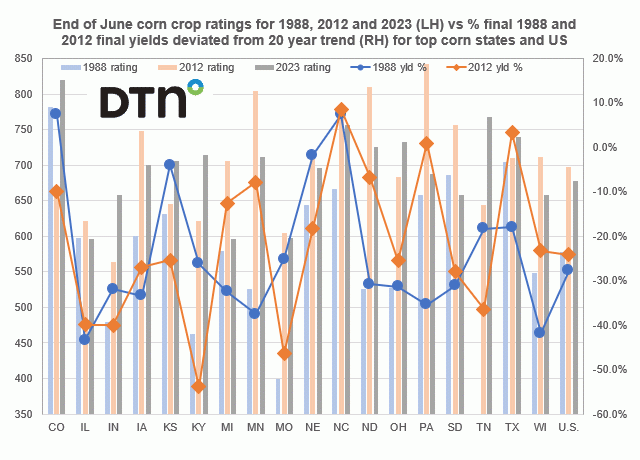DTN Fundamentally Speaking
Corn Planted vs. Intentions
In its prospective plantings report on March 31, USDA indicated that U.S. farmers planned to seed 89.5 million acres of corn which was far lower than the trade's 92.0 million-acre estimate.
There is always a question of how many of the 73,000 respondents are being truthful for though USDA has methodology to detect biases, there is clearly incentive for a farmer to low ball both acreage and stock figures.
Given the time lag between the March survey period and when plantings really get going in April and May, Mother Nature and changing prices have resulted in large changes from what farmers intend to plant and what they actually put in the ground in the past.
Notwithstanding a soybean-corn ratio that was in favor of corn, one has to say the fact that fertilizer prices are double or even triple year ago levels prompted farmers to plant more soybeans, a cheaper crop to put in the ground.
P[L1] D[0x0] M[300x250] OOP[F] ADUNIT[] T[]
Along these lines, this graphic shows the change in planted area for U.S. corn from the March intentions to the June acreage report in thousand acres on the right-hand axis vs. the November soybean/December corn futures price ratio on April 1 and again on June 1 plotted on the left-hand axis.
Also shown in the yellow boxes is the percent of the U.S. corn crop planted by May 20 each year from 1996 to 2022.
It is thought that corn acreage declines from the March prospective plantings to the June acreage report stem from two factors, one of which is weather, especially if it is bad meaning usually cold and wet where it gets too late in the season for some farmers to continue to seed corn and instead switch to a crop that can be planted later which in the Midwest is very often soybeans.
Then there is changing economics where either corn or soybean prices become more or less attractive on a relative basis or if possible, farmers can adjust their plantings based on this consideration.
Here we use the new crop soybean corn ratio where 2.35 is considered the magic number.
A ratio over this implies greater soybean area while conversely a ratio less than 2.35 would imply increased corn acreage relative to soybeans.
This year 68% of the crop was planted as of May 20 which, other than the 50% seeded as of that date in 2019, is the lowest since 1996 and implies even lower planted area than the 89.5 million acre March intentions figure.
On the other hand, this year's SX/CZ ratio on April 1 was 2.04 which, other than the 1.94 ratio on 4/1/2008, appears the lowest level for that date since 2001.
The SX2022/CZ2022 ratio of 2.19, other than the 2.05 figure on 6/1/2019, is the lowest since 2011 which suggests more corn and less soybeans as trade estimates are for a 300,000-acre gain in the former and about a half a million acres less soybeans seeded than the March 31 figure of 91 million acres.
(c) Copyright 2022 DTN, LLC. All rights reserved.




